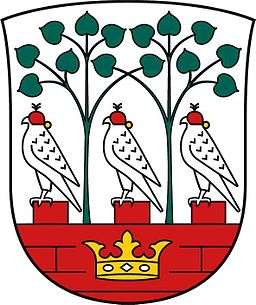Frederiksberg
| Frederiksberg | ||
|---|---|---|
|
Frederiksberg Palace seen from the park | ||
| ||
|
| ||
| Coordinates: DK 55°40′N 12°32′E / 55.667°N 12.533°E | ||
| Country | Denmark | |
| Region | Capital (Hovedstaden) | |
| Municipality | Frederiksberg | |
| Government | ||
| • Mayor | Jørgen Glenthøj | |
| Area(co-extensive with its municipality) | ||
| • Total | 8.7 km2 (3.4 sq mi) | |
| Population (2015) | ||
| • Total | 103,192 | |
| • Density | 11,861/km2 (30,720/sq mi) | |
| Time zone | Central Europe Time (UTC+1) | |
| Website |
www | |
Frederiksberg (Danish pronunciation: [fʁæðʁæɡ̊sˈb̥æɐ̯ˀ]) is a part of the Capital Region of Denmark. It is formally an independent municipality (town), Frederiksberg Municipality,[1] but is typically treated as a part of Copenhagen.[2][3] It occupies an area of less than 9 km2 and had a population of 103,192 in 2015.[4]
Frederiksberg is an enclave surrounded by Copenhagen Municipality and there is no clear border between the two. Some sources ambiguously refer to Frederiksberg as a quarter or neighbourhood of Copenhagen.[3] However, Frederiksberg has its own mayor and municipal council, and is fiercely independent.
Frederiksberg is considered to be an affluent, or "posh", area.[3] The town is characterised by its many green spaces, such as the Frederiksberg Gardens and Søndermarken. Some institutions and locations that are widely considered to be part of Copenhagen are actually located in Frederiksberg. For example, Copenhagen Zoo as well as several stations of the Copenhagen Metro (the stations Forum, Frederiksberg, Fasanvej, Lindevang, and Flintholm) are located in Frederiksberg. The Copenhagen S-train system also has several stations in Frederiksberg, including Peter Bangs Vej station and Flintholm station.
History
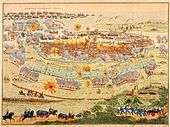
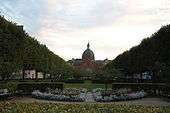
Frederiksberg's original name was Tulehøj (= Thyle-hill),[5] indicating that a thul (= thyle) lived there, the reciter of eldritch times. The term is known from the Snoldelev rune stone.[6] In Beowulf, Unferth holds the same title. In Håvamål, Odin himself is referred to as "the old thul".[7] Thula translates as "song", like in the Rigsthula poem from the Edda. By 1443 the name Tulehøj was spelled Tulleshøy. It was regarded as Copenhagen's border to the west.[8] People lived here since the Bronze Age.
The history of Frederiksberg goes back to June 2, 1651 when King Frederik III gave 20 Danish—Dutch peasants the rights to settle at Allégade (= allé = tree-lined street, gade = street), and founded the town then named "Ny Amager" (= New Amager) or "Ny Hollænderby" (= New Dutchman-town). Farming was not very successful, and in 1697 most of the town burned down. This meant that the peasants were unable to pay taxes, and the land reverted to the crown by Frederik III's son Christian V.
In 1700-1703, King Frederik IV built a palace on top of the hill known as Valby Bakke (bakke = hill). He named the palace Frederichs Berg, and the rebuilt town at the foot of the hill consequently changed its name to Frederiksberg. A number of the local houses were bought by wealthy citizens of Copenhagen who did not farm the land, but rather used the properties as country houses.
The town changed slowly from a farming community to a merchant town, with craftsmen and merchants. During the summer rooms were offered for rent, and restaurants served food to the people of Copenhagen who had left the cramped city for the open land, and to be near the royals.
Initially the town grew slowly with population growing from 1,000 in 1770, to 1,200 in 1800, and to 3,000 in 1850.
In 1852 Parliament removed restrictions which prohibited permanent construction outside Copenhagen's city walls. Almost immediately numerous residential areas were constructed, starting in the eastern part near Copenhagen, and ending in the western part farthest away from Copenhagen in 1950. This led to rapid population growth; in 1900 the population reached 80,000, and in 1950 the city peaked with a population of 120,000.
Today the city consists almost entirely of 3- to 5-story residential houses, large single-family homes, and large parks; only a few small areas with light industry remain. On aerial pictures Frederiksberg stands out from the surrounding city of Copenhagen as a green area with few large roads. It is considered to be one of Copenhagen's more prestigious areas to live in.
Geography
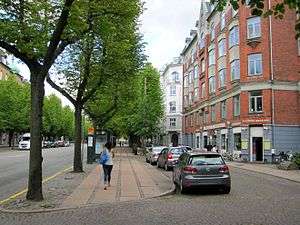
Frederiksberg, which lies west of central Copenhagen, is completely surrounded by boroughs forming part of the city of Copenhagen – the result of an expansion of the Copenhagen Municipality's boundary in 1901, which nevertheless did not include Frederiksberg in the list of municipalities to be incorporated in the enlarged area. Frederiksberg is thus effectively a municipal island within the country's capital – a unique phenomenon in present-day Europe. Other than administratively, however, it is largely indistinguishable in character from the districts of Copenhagen city which surround it.[3]
The town has several stations on the Copenhagen Metro system, and is home to the tallest residential structure in Denmark and the second tallest residential building in Scandinavia: the 102-metre high Domus Vista.
Culture
The Danmark Rundt cycling race traditionally finishes on Fredericksberg Alle, often in a sprint finish.
Education
Frederiksberg houses the University of Copenhagen's Frederiksberg Campus, Copenhagen Business School, 9 public schools (run by the municipality), 3 private schools, 1 technical college, and more.
The Lycée Français Prins Henrik, a French international school, is in Frederiksberg.[9]
Shopping
The 3 streets Gammel Kongevej, Godthåbsvej, and Falkoner Alle are the busiest shopping streets. The town also houses the Frederiksberg Centret shopping mall.
Main sights
- Frederiksberg Campus (University of Copenhagen)
- Frederiksberg Gardens
- Frederiksberg Hospital
- Frederiksberg Palace
- Frederiksberg Town Hall
- Copenhagen Business School
- Copenhagen Zoo
- Royal Danish Military Academy
Demography
Population of Frederiksberg (from 1769):
|
|
|
|
Transport
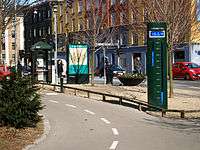
The town is served by the Frederiksberg station and the Fasanvej station, opened in 2003 on the Copenhagen Metro. It serves the M1 and M2 lines and is connected with bus services. Once completed in 2017, the station will also serve M3 (the City Circle Line) providing an interchange between it and the existing Metro lines.
The S-Train urban rail and suburban rail network can be reached through Peter Bangs Vej station, Fuglebakken station and Grøndal station.[10]
Notable residents
- Stein Bagger
- Lars Barfoed
- Anders Bodelsen
- Carl Theodor Dreyer
- Henning Carlsen
- Chanée
- Pia Gjellerup
- Christian Grøthan
- Carl Christian Hall
- Asger Hamerik
- Jesper Langberg
- Michael Laudrup
- Per Stig Møller
- Leif Panduro
- Robert Storm Petersen (Storm P)
- Birgitte Price
- Gerda Wegener
Twin towns
References
- ↑ "Is Frederiksberg part of the City of Copenhagen?". kk.dk. The City of Copenhagen. Retrieved 15 April 2016.
- ↑ "Areas of Copenhagen". visitcopenhagen.com. VisitCopenhagen / Wonderful Copenhagen. Retrieved 15 April 2016.
- 1 2 3 4 "Guide to Frederiksberg in Copenhagen". visitcopenhagen.com. Wonderful Copenhagen. Retrieved 16 April 2016.
Frederiksberg is a fashionable part of Copenhagen with excellent shopping opportunities and green spaces.
- ↑ "Statistikbanken Table FOLK1". Statistikbanken.dk. Retrieved 2015-02-11.
- ↑ "Gravhøien paa Dyrehavegaard" (PDF). Retrieved 2010-11-15.
- ↑ http://runer.natmus.dk/VisGenstand.aspx/Titel/Snoldelev-sten
- ↑ "de beste bron van informatie over normanni i. Deze website is te koop!". normannii.org. Retrieved 2010-11-14.
- ↑ "Rostgaard: Dend Kongelige Residents= og Stabel=Stad Kiøbenhavn". Eremit.dk. 2002-03-17. Retrieved 2010-11-14.
- ↑ "Plan d’accès/"Sådan finder du skolen." Lycée Français Prins Henrik. Retrieved on 21 April 2015. "Federiksberg Alle 22A, 1820 Frederiksberg, Denmark"
- ↑ "S-tog stationer i København, Danmark | Nelso" (in Danish). Nelso.dk. Retrieved 2010-11-14.
External links
| Wikimedia Commons has media related to Frederiksberg. |
 Frederiksberg travel guide from Wikivoyage
Frederiksberg travel guide from Wikivoyage- Frederiksberg official website

